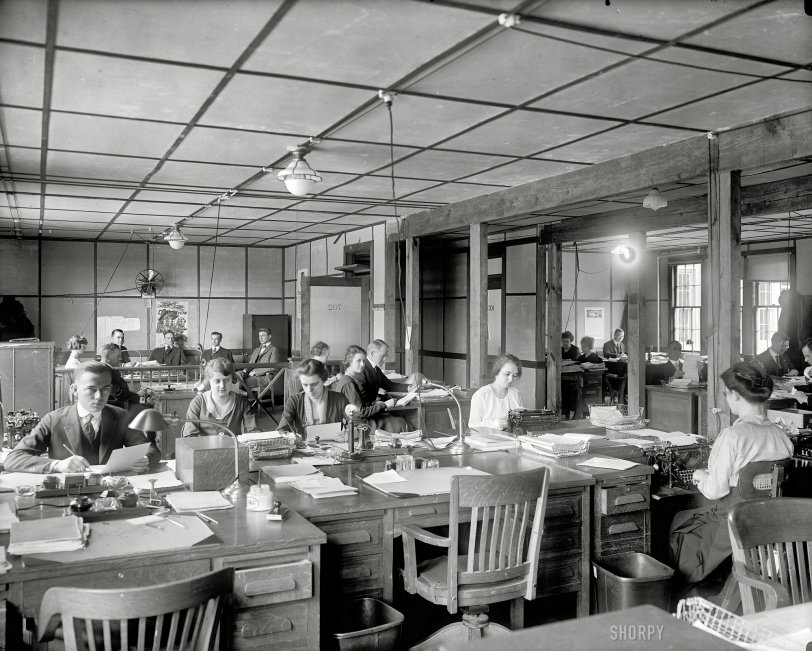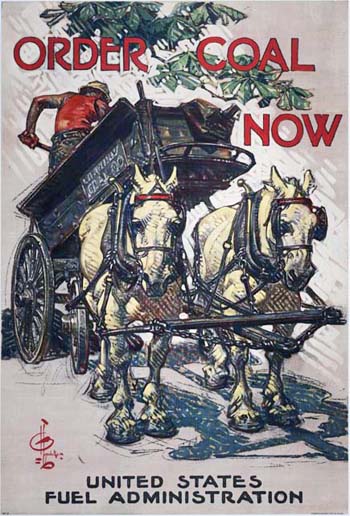


Framed or unframed, desk size to sofa size, printed by us in Arizona and Alabama since 2007. Explore now.
Shorpy is funded by you. Patreon contributors get an ad-free experience.
Learn more.

- Freeze Frame
- Texas Flyer wanted
- Just a Year Too Soon
- WWII -- Replacing men with women at the railroad crossing.
- Yes, Icing
- You kids drive me nuts!
- NOT An Easy Job
- I wonder
- Just add window boxes
- Icing Platform?
- Indiana Harbor Belt abides
- Freezing haze
- Corrections (for those who care)
- C&NW at Nelson
- Fallen Flags
- A dangerous job made worse
- Water Stop
- Passenger trains have right of way over freights?
- Coal
- Never ceases to amaze me.
- Still chuggin' (in model form)
- Great shot
- Westerly Breeze
- For the men, a trapeze
- Tickled
- Sense of loneliness ...
- 2 cents
- Charm City
- What an Outrage
- Brighton Park
Print Emporium
Fuel Administration: 1919

Washington, D.C., circa 1919. "U.S. Fuel Administration." Whose turn is it to clean out the microwave? Harris & Ewing Collection glass negative. View full size.
Headed for the GSA warehouse
Ever seen one? I have. In the late 1980's at the Presidio of San Francisco, but it's gone now, without a trace. The U.S. Army kept all of its "used" equipment behind a steel cyclone fence, just a mile or so south of the Golden Gate Bridge, near Fort Point.
Desks, filing cabinets, old trucks and truck parts, broken medical machines, everything was piled there in a sort of "organized confusion." The General Services Agency was "in charge" of this mess, but you'd never see anyone taking care of it. All the ancient equipment sat there in the fog and the rain, making it a great home for feral cats (among other creatures).
It's long since been removed, but what did they do with all those Government-issue desks?
"Take a Letter, Miss..."
The prettiest girl is sitting thisclose taking dictation from the best looking guy, who looks managerial.
He is pretending to be concentrating. She is a dazzling flirt. We have a TV sitcom brewing here.
Fuel Admin building
This was across from the War Trade Board at 20th Street and New York Avenue. Along with the Food Administration and War Department buildings it was among the WWI structures constructed in great haste in the late teens around Washington. Drywall and prefabricated partitions and panels were used extensively.
Modern Design
This office probably was considered very forward thinking for its time. I wonder what office designers 75 years from now will think of our cubicle office layouts of today.
Your desk.
So does your desk also have the little round lock on the center drawer? That was the kicker for me. I don't have the key, but it's not locked.
Bet's most of it is still being used...
Amazingly I see office furniture just like this all the time and I would bet that some of it is being used right now. Sturdy stuff especially the chairs. I know where several are, and they are in perfect working order, although not in an "office" anymore. The Oak desks look really well made too. Now office furniture is nothing but wood pulp and glue.
Tube and post wiring
That's some first-generation tube and post electrical wiring there, always amazes me that there weren't more fires and fatalities than there were with that kind of primitive set-up in homes and businesses. Combined with the raw wood beams, I'd guess that this building was not originally intended to be office space for a bureaucracy.
[It seems to have been constructed specifically to house the Fuel Administration. - Dave]
Flip tops
The gals typing at right are sitting at flip-top desks. You can just see the handle of the flipper on the desk of the girl nearest us. You pull that handle up and toward you, and the typewriter disappears below. It ends up sitting at an angle of about 45 deg and reducing your leg room, but you get a nice clean desk top.
The typewriter is bolted to the platform. I have such a desk and such a typewriter affixed thereto. Got it surplus from Oak Ridge Labs, but it doesn't glow in the dark. Okay, I'm going to order some coal now.
I'm sitting at a desk like that, too!
The side drawers have the same type of handles.
I really like this picture. I find it aesthetically pleasing, and I could sit and look at it for hours!
What was the Fuel Admin?
I was curious what the department did.
Fuel Administration, a World War I agency instituted 23 August 1917 under authority of the Lever Act. The agency exercised control over the production, distribution, and price of coal and oil.
Its main activities were to
(1) stimulate an increase in the production of fuel
(2) encourage voluntary economy in the private consumption of fuel
(3) restrict consumption by industries not essential to winning the war
(4) regulate the distribution of coal through a zoning system
(5) check the inordinate rise of fuel prices by fixing maximum prices within each zone.
Characteristic of its methods for inducing voluntary conservation was its appeal to people residing east of the Mississippi River to observe "gasless Sundays." The Fuel Administration ceased to function on 30 June 1919.
"Open Office" Design
It looks like they moved everyone in before finishing the building. That is, what probably would have been "Room 703" has, for some reason, no outer wall. I guess security wasn't much of a concern... it's more important that the bigwigs in 702 have a cozy spot to sit around in, congratulating themselves for designing that "Order Coal Now" poster. It's the cat's pajamas!
My desk is very similar to these, and just about as old, except that it has round drawer knobs and rounded corners. I don't know its complete history, but it belonged to my great-aunt, who used to do her homework on it. Now, it has a PC monitor and keyboard sitting on top, something the people who made it never could have envisioned.
That Glare
The very serious fellow on the left is telepathically sending out the command "Order Coal Now."
RE:What this photo is about
I agree, that smile says "I do more than steno"!
I am presently sitting....
at a desk exactly like the one in the foreground. The chair on the desk to its right is the one that came with my desk.
Must have made a lot of them.
Les Nessman's dad worked here
Nice doors...no money to finish the walls.
Fixtures
Love those light fixtures. They're elegant and I bet they cast a nice combination of diffuse and reflected light.
What this photo is about
You'd think it was supposed to be about a busy, crowded government office, but what it's really all about is that gal in the center with her steno pad, glancing at the camera with that beguiling smile.
Rustic
This place looks like the inside of a barn! Corporate America could learn a thing or two about office design from this photo.
Desks
These sturdy desks keep showing up. Whoever made them and whoever had stock in the company probably made a fortune. Hmm -- maybe not, since they don't seem to wear out.
But no Burger King Wrappers to be Seen
Office pictures are always interesting. What are they using that would not be found in any form on a desk today? How does the desk in a modern cube compare? There are lots of inkwells, dipping pens, blotters. All ubiquitous at the time, completely gone now. What is that box on the left-most fellow's desk? Intercom? Each desk has a metal waste can. There are telephones, electric lamps (dropped wires: how long did it take folks to think about putting in outlets at knee or floor level?). "In and out" baskets. Interesting cane-backed office chairs. I don't remember seeing any like that before. Look at the typewriter desk configuration. Not unlike today's pull out keyboard trays. Someone should send this photo to the folks at Rejuvenation Lighting to copy those overhead light fixtures! There are staplers, flip calendars, paste pots, but no ashtrays?
I'd like to get to know the secretary who is looking at us from the middle of the picture.
Hey you...
Yes you ... centre back...get away from my girl.... sure, your pretending to go over fuel numbers, but I see through your suave slicked back blonde hair....get away I say!!!

























On Shorpy:
Today’s Top 5